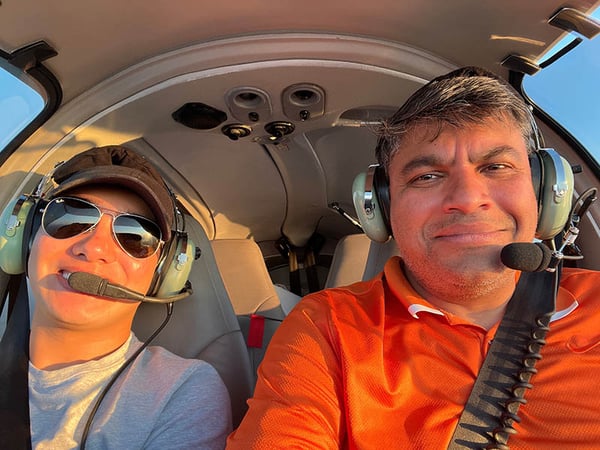
Have you ever wondered how to master a skill or teach it effectively to someone else? Let me take you on a flight through an amazing journey of one student, and show how the Genie Academy teaching philosophy can change the game.
I once took Yadu, a former Math Genie student on a joyride in my Cessna 150. As we approached for landing and I dialed back the engine RPM for descent, Yadu's keen observation caught my attention. He immediately noticed the change in engine noise and the plane's pitch. Not many first-timers can pick up on such subtleties. It became clear to me: this kid had potential.
Two and a half years later, Yadu had racked up 42.5 flying hours under his belt, tutored by an experienced flight instructor. Yet, he hadn’t soloed. The pandemic added its set of challenges, but the real hurdle was somewhere else.
For those unfamiliar, the first solo is a rite of passage for every pilot, signifying their ability to fly alone, unassisted by an instructor. While many aspire, few reach this milestone. Conventional wisdom says that most pilots solo between 15-25 hours. However, I myself took almost triple that time, cycling through four instructors. Witnessing Yadu's prolonged journey to his solo made me uneasy.
Dick, Yadu's instructor and also my fourth instructor, is a true veteran of the skies. He's proficient, patient, and kind, a combination you'd think perfect for teaching. However, there lay the paradox. The very vastness of his experience became the blind spot. Dick was teaching from the vantage point of a master, often diving into advanced concepts and nuances, overwhelming young Yadu in the process.
Here's where I introduced the game-changer: The Shu Ha Ri framework which is part of the Genie Academy teaching philosophy.
**Shu** – the beginning stage: Think of it as the 'Wax on & Wax off' phase from the movie 'Karate Kid'. The focus is on breaking down tasks to their simplest form.
I sat down with Yadu and we dissected the basic flight pattern around an airport. From taxing, take off, turns, final approach and touchdown. Mapping out RPMs, airspeeds, flap settings, nose attitude at every stage, we turned abstract concepts into tangible steps. First I wrote it down on a piece of paper. Yadu then rewrote it several times till they got ingrained in his mind. We watched videos and discussed each stage of flying the pattern. He did a visualization exercise visualizing the successful completion of each stage. All of this took about 1.5-2 hours.
The result? On his next flight, Yadu exhibited such clarity and confidence that Dick immediately cleared him for his first solo. Watch Yadu's first landing below!
So, what’s the takeaway? Whether you're learning or teaching, learn the Shu Ha Ri concept. Whatever your 'flying' is, the Shu Ha Ri framework might just be the wind beneath your wings.
Happy Learning or Teaching.





